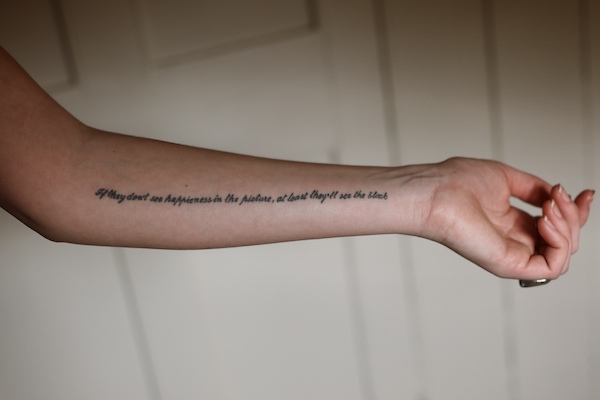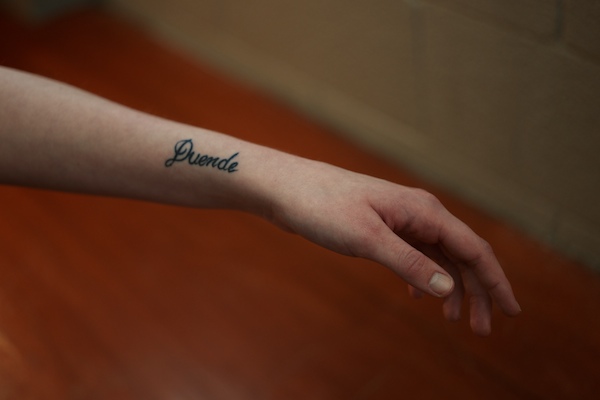LIZZY'S TATTOO
Glendyn Ivin
"If they don't see happiness in the picture, at least they'll see the black" Chris Marker

Use the form on the right to contact us.
You can edit the text in this area, and change where the contact form on the right submits to, by entering edit mode using the modes on the bottom right.
123 Street Avenue, City Town, 99999
(123) 555-6789
email@address.com
You can set your address, phone number, email and site description in the settings tab.
Link to read me page with more information.
The process diary of film director Glendyn Ivin
Filtering by Category: Photography
"If they don't see happiness in the picture, at least they'll see the black" Chris Marker

I tried to document 'the extras' on the set of Puberty Blues when ever I could. Wardrobe designer Emily Serensin and hair and make-up designer Chiara Tripodi did such a great job I felt compelled to momentarily bring them them to the foreground rather than just 'background'.

A couple of posts ago I mentioned the Apocalypse Now mash-up featured one of my all time favorite quotes about filmmaking. Francis Ford Coppola dreaming of the day when the professional (out of reach) world of filmmaking would fall away and technology would allow "a little fat girl from Ohio" to make a beautiful film with her fathers camera. There is no doubt the democratisation of filmmaking which Francis prophesied is well and truly with us. Some truly great cinema has been made with minimal 'off the shelf' equipment. I still get excited by a back-pack full of gear (camera, microphone, laptop) being all you really need to shoot and edit a film. With more recent cameras like the 5D greater aesthetic and quality control has been firmly placed in our hands and I'm in still in awe at whats possible with a DSLR's these days.
But today I was sent a box which I believe contains the next giant leap forward in breaking down the technology wall. The Blackmagic Cinema Camera is a very new and very exciting camera. It provides stunning, jaw dropping image quality (Pro-res or 2K uncompressed RAW) that is so far above and beyond what any DSLR can provide. It's built like a brick and everything that plugs in and out of it has professional connectors that are strong and reliable. No more mini-jacks and fiddly HDMI. It records onto removable SSD and this version comes with an EF (Canon) lens mount.
The Blackmagic doesn't have a lot of bells and whistles. Infact it's really basic in it's design and feature set. Personally I find this refreshing. Anything it doesn't do, and it does have limitations, in my mind is instantly erased by how much it costs, a mere $3000(!). I've seen this camera up against the Alexa in the grading suite and it's comparative in look and feel. It's different of course, but not $70 000 different. And way, way different to say a 5Dmk3 which cost the same.
I'm planning on testing the camera from a directors perspective as apposed to a cinematographers. I'm not overly technical though. I'm sure there will be a ton of sites out there providing all the specs and pixel peeping tests that will do a way better job of the geek speak than me. I just want to know it's a reliable easy to use camera that provides good colour depth and gives me gradable detail in the highlights and in the shadows. I kind of already know the Blackmagic does this in spades. DOP John Brawley help test and develop the camera with Blackmagic Design and we used it a little on Puberty Blues. (John has a bunch of info and tests on his blog). But the camera we used then was a beta model and the one I'm holding below is the production one. It will soon to be flying off the shelves and into the hands and hearts of filmmakers around the world.
Nice article over on the Digital Pictures website with me and cinematographer John Brawley talking about 'the look' of Puberty Blues. People get obsessed with 'the look' of things, but a lot of the time I think and hope they are talking about 'the feel'. I do love the way Puberty Blues looks, but I'm much more happy with the way it feels. 'JB' is not only a great DOP, he has over the time we have spent shooting 'Puberty' and other things become a good friend. He is a true and valued collaborator and someone who as a director you want and need at your side while fighting the daily battles of film production.
JB with boom swinger Mark Van Kool and cheeky Ashleigh Cummings poking her head in!
Last week I was in New Zealand casting for a commercial. I met a 17 year old girl who had the word 'Duende' freshly tattooed on her arm. Later, I googled the word and found it's meaning fascinating. A wonderful word which goes some way towards describing the indescribable. The elusive, beautiful darkness we are drawn to in music and film and all art in general. I never knew it even had a word to describe it.

Australian music artist Nick Cave discusses duende in his lecture pertaining to the nature of the love song (Vienna, 1999):
In his brilliant lecture entitled "The Theory and Function of Duende" Federico García Lorca attempts to shed some light on the eerie and inexplicable sadness that lives in the heart of certain works of art. "All that has dark sound has duende", he says, "that mysterious power that everyone feels but no philosopher can explain." In contemporary rock music, the area in which I operate, music seems less inclined to have its soul, restless and quivering, the sadness that Lorca talks about. Excitement, often; anger, sometimes: but true sadness, rarely, Bob Dylan has always had it. Leonard Cohen deals specifically in it. It pursues Van Morrison like a black dog and though he tries to he cannot escape it.Tom Waits and Neil Young can summon it. It haunts Polly Harvey. My friends the Dirty Three have it by the bucket load. The band Spiritualized are excited by it. Tindersticks desperately want it, but all in all it would appear that duende is too fragile to survive the brutality of technology and the ever increasing acceleration of the music industry. Perhaps there is just no money in sadness, no dollars in duende. Sadness or duende needs space to breathe. Melancholy hates haste and floats in silence. It must be handled with care."
All love songs must contain duende. For the love song is never truly happy. It must first embrace the potential for pain. Those songs that speak of love without having within in their lines an ache or a sigh are not love songs at all but rather Hate Songs disguised as love songs, and are not to be trusted. These songs deny us our humanness and our God-given right to be sad and the air-waves are littered with them. The love song must resonate with the susurration of sorrow, the tintinnabulation of grief. The writer who refuses to explore the darker regions of the heart will never be able to write convincingly about the wonder, the magic and the joy of love for just as goodness cannot be trusted unless it has breathed the same air as evil - the enduring metaphor of Christ crucified between two criminals comes to mind here - so within the fabric of the love song, within its melody, its lyric, one must sense an acknowledgement of its capacity for suffering. [via wiki]
Just in time for the premiere of Puberty Blues (on air tonight!) comes the republishing of the original book by Kathy Lette and Gabrielle Carey. Long out of print and off the shelves, the new edition has been co-published just in the nick of time by Text Publishing and Random House. "Puberty Blues is raw, humorous and honest: a compelling account of teenagers navigating the chaos of life. It is one of the great coming-of-age stories in Australia, and it remains as relevant now as when it was first written over three decades ago."
Even though the series was developed to expand the world of the characters beyond the pages of the book, it's the brutal honesty with which the story is told on the page that is the very essence of the story and we were very conscience to bring that same essence into the eight hours of TV.
As a huge fan of the book I was very chuffed that one of my photos of Debbie and Sue (taken on set while directing Episode 3) was used as the front cover image!
A book of my photographs taken while making Puberty Blues. The first image below is of Ashleigh Cummings, who plays Debbie. I took the photo when I first met her at Mullinars Casting for her initial screen-test November, 2011. Second image, Sue (Brenna Harding) and Debbie going nowhere fast in the front seat of a panel van.
More details soon...